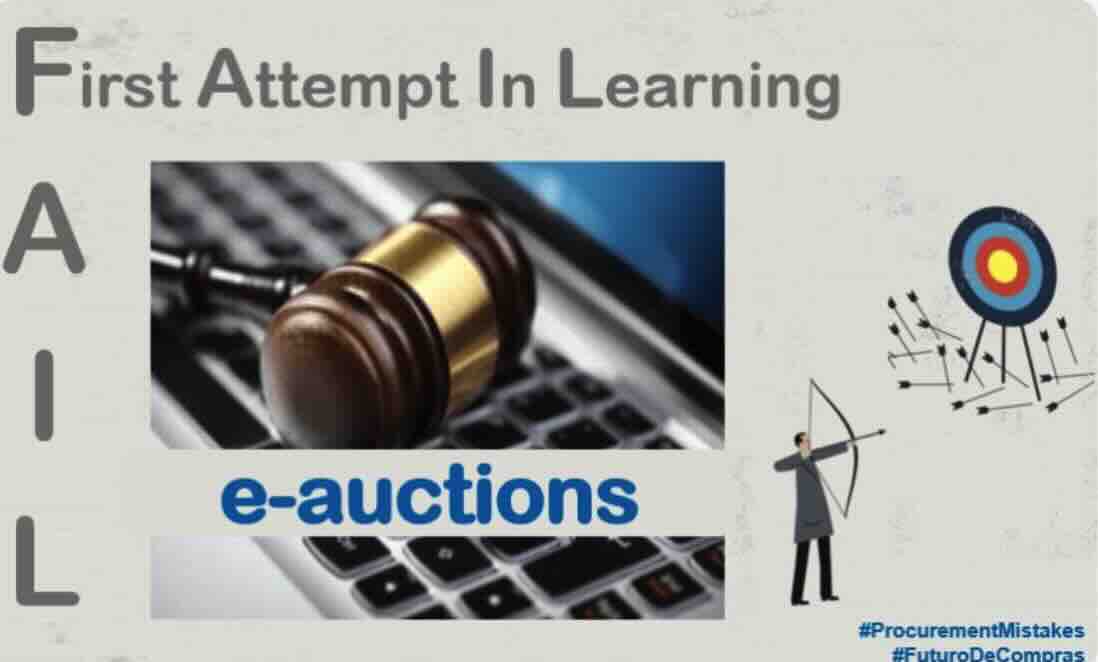I failed at e-auctions. My first e-auction was in 1997. Not the best experience I had; at that time, connectivity was a real issue. Since then, I have done, pushed, seen dozens of them and I became a fan. /// Stéphane Morel
Content…
First Attempt In Learning
We could spend hours speaking about the issues and disadvantages of e-auctions.There are few reasons to still justify a low usage rate:
- The biggest obstacle is ourselves. As professional buyers, we are the first issue through massive resistance.
- Awarding based on the best price is often a mistake. The e-auction platform vendors used it in their sales pitch and it is a bad tactic in most cases. Instead, we should be asking suppliers for their best & binding offer during the event; this offer is one line as part of an overall decision matrix (I am not a big fan of weighted e-auctions).
- Wrong understanding of the methodology: e-auctions require strong supplier RFx onboarding and communication; clear lots and templates for the offers; the weight of the e-auction as part of the overall decision matrix is defined with the stakeholders before the event; you often need a 1st pre-event to get a good baseline and comparable offers for the event.
Few measures can improve the deployment of e-auctions
We can:
- Make sure that the team, stakeholders and suppliers understand what it means.
- In sensitive cases, work with stakeholders on the “plan B” (what could happen and what to do if the event “fails”); it is like our BATNA in traditional negotiations.
- Select 1 or 2 good events (simple purchase in a highly competitive supply market) to start with and then scale up.
My hints:
- Make e-auction as the standard rule and buyers will have to justify why they can’t apply it. It is a bit narrow minded but, by experience, resistance is super high.
- E-auctions require expert support. You can build an internal pool of experts supporting the sourcing / category mgrs.; or you hire an external specialized provider. In both cases, it comes with a cost but pay-back is immediate.
- Do not only e-auction prices; e-auction cost breakdowns for components or services. You create a fictitious lot with cost breakdown templates. If the suppliers have to enter a final “calculated” price during the event, the most important step & criteria are to receive post-event the templates who lead to the offered final price. Those cost breakdowns will be the basis for the contract and future real price calculations.
- Invite the RFx team and stakeholders to look at the event. It is amazing to see the reaction of the people when they see the offers coming in. Without saying anything on the prices, it is a huge opportunity for Procurement to influence the business talking about all the other meaningful awarding criteria.
Contact Stéphane Morel at LinkedIn
I failed at e-auctions – summary and recommendation
Learn more about e-auctions in the course Introduction to Procurement E-Auctions (Course 1 of 4 ). In step 3 of LHTS standard sourcing process the sourcing tactic of the event is decided. The characteristics of the supplier market and the product/service about to be sourced are defined and thereby also the negotiation method (and how to approach the market). But when should e-auction be chosen as a the preferred negotiation method…?
- In this course the student will learn the most common standard methods and how/when e-auction should be applied.
- This course is designed to empower students with the skills to effectively decide when e-auctions are the optimal negotiation method, enhancing their capabilities in tactical procurement roles.
Understanding the concept of a procurement e-auction, as one of the negotiation methods that can be applied, is a key skill for the tactical buyer role. The course comprehensively covers the various standard methods in procurement and provides in-depth guidance on when and how e-auctions should be strategically utilized. This program is designed to empower students with the skills to effectively decide when e-auctions are the optimal negotiation method, enhancing their capabilities in tactical procurement roles. Stéphane failed at e-auctions, you can succeed.
Note: Illustration to the post “I failed at e-auctions. Now I know better!” was provided by Stéphane Morel
